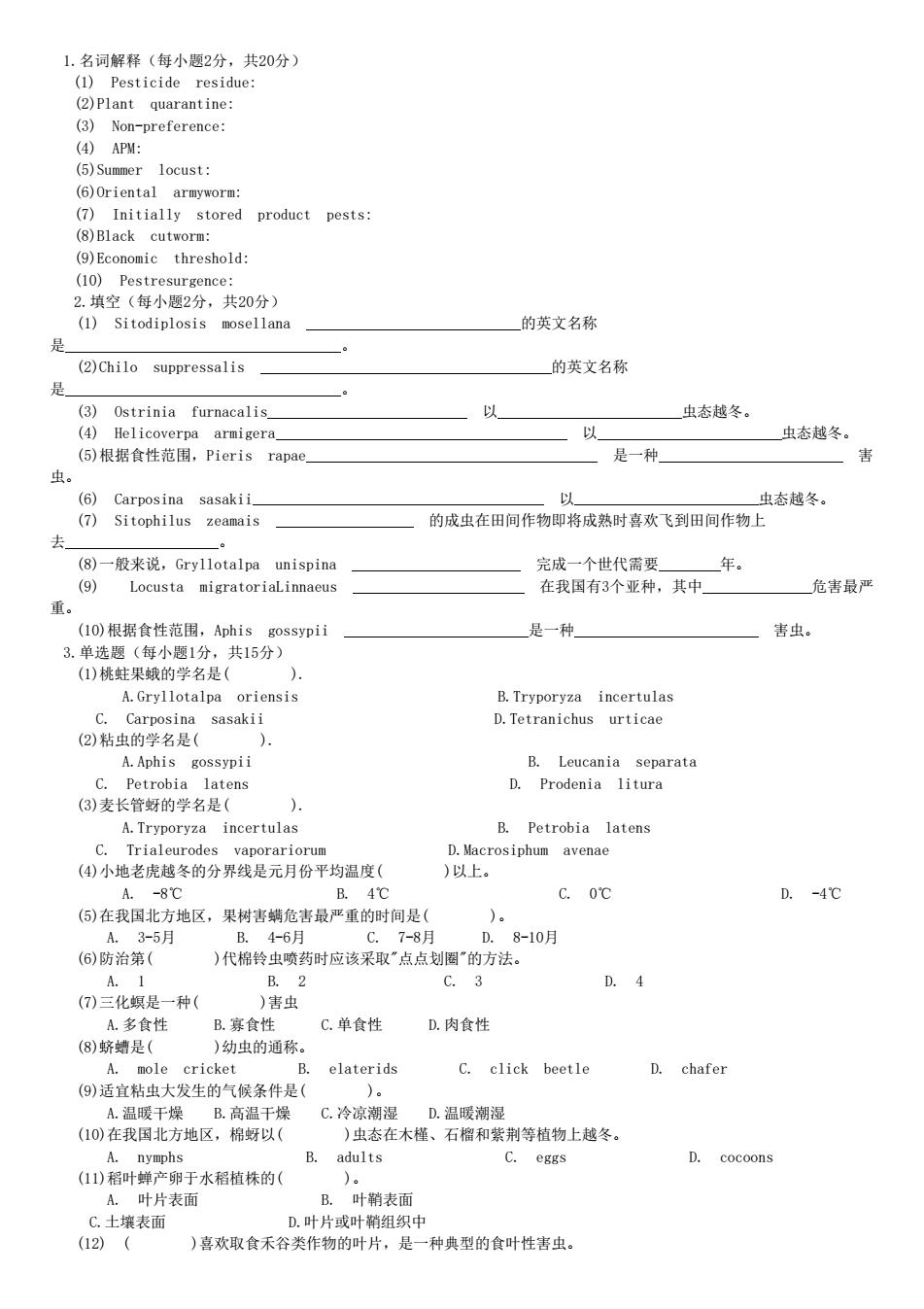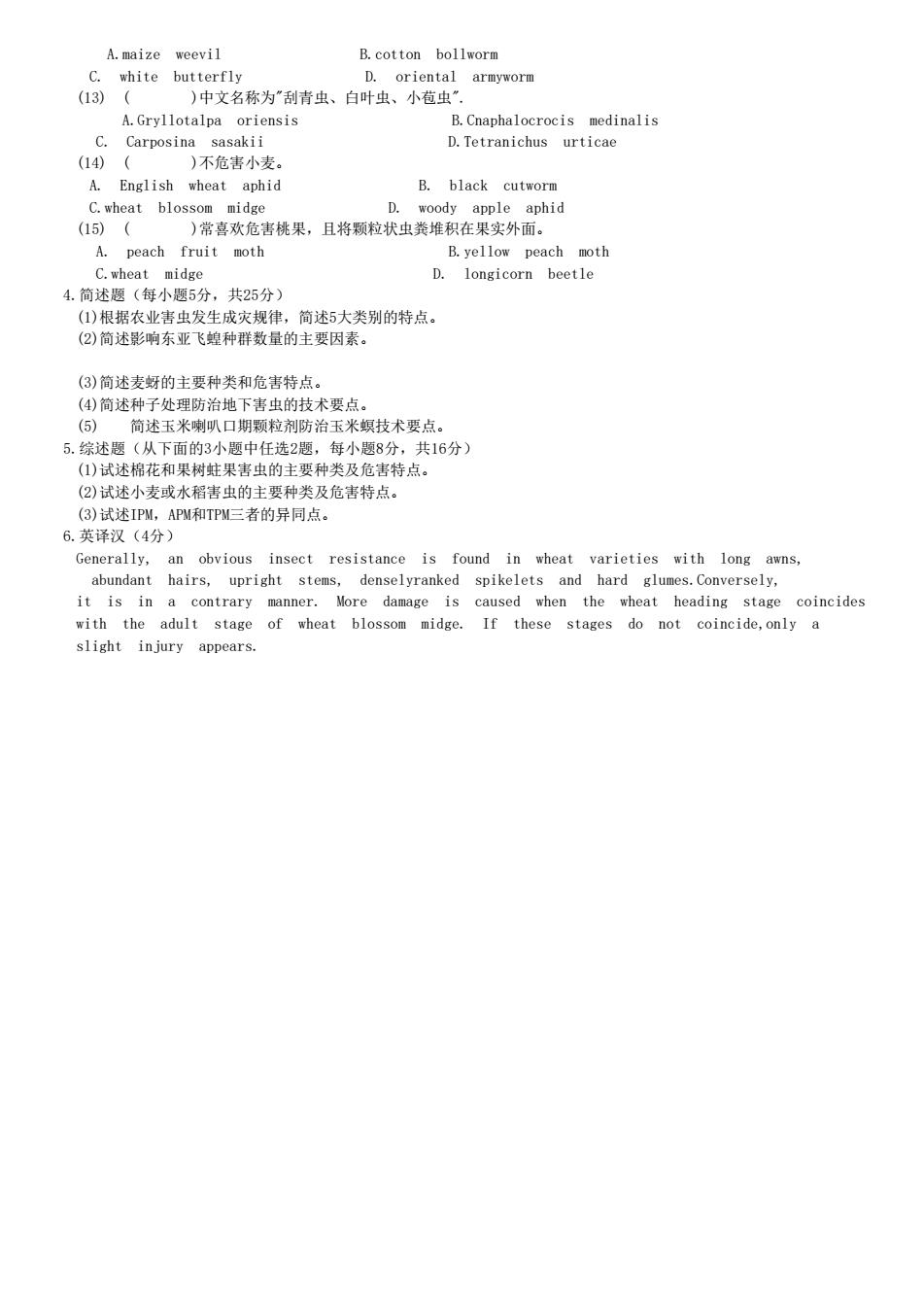
1.名词解释(每小题2分,共20分) (1)Pesticide residue: (②)Plant quarantine (3)Non-preference: (4)Ap: (5)Summer locust. (6)Oriental armyworm- (7)Initially stored product pests: (8)Black cutrorm: (9)Economic threshold: (10)Pestresurgence: 2.填空(每小腰2分,共20分) (1)Sitodiplosis mosellana 的英文名称 是 (2)Chilo suppressalis 的英文名称 是 (3)Ostrinia furnacalis_ 以 虫态越冬, (4)Helicoverpa armigera_ 虫态越冬。 (⑤)根据食性范围,Pieris rapae 是一种 虫。 (6)Carposina sasakii. 虫态越冬 (7)Sitophilus zeamais 的成虫在田间作物即将成熟时喜欢飞到田间作物上 (⑧)一般来说,Gryllotalpa unispina 一个世代需要 年。 (9) Locusta migratoriaLinnaeus 在我国有3个亚种,其中 危害最严 (10)根据食性范田, Aphis gossypii 是一种」 害虫 A.Gryllotalpa oriensis B.Tryporyza incertulas ②虫的学名是 sasaki D.Tetranichus urticae gossypii B.Leucania separata (@)支长管蚜的学名是 Prodenia litura AT B.Petrobia latens C.Trialer ④小地老虎越冬的分界线是元月份平均温度( D.Macrosiphum avena )以上。 -9 c.0℃ D. (6)在我国北方地区,果树螨危吉最严重的时间是( 3-5月 A-6日 n 8-10月 (6)防治第( )代棉铃虫喷药时应该采取“点点划圈“的方法 R 2 D.4 (7)三化螟是一种( )害虫 A.多食性 B.寡食性 C,单食性 D.肉食性 (⑧)蛴塘是( )幼虫的通称。 A mole cricket B.elaterids C.click beetle D.chafer (⑨)适宜粘虫大发生的气候条件是( A温暖干燥 B高温干提 C.冷凉潮混 D.温暖海湿 (10)在我国北方地区,棉蚜以( )虫态在木槿、石榴和紫荆等植物上越冬。 A.nymphs B.adults C.eggs D.cocoons (11)稻叶蝉产卵于水稻植株的( 。 A.叶片表面 B。叶鞘表面 C土壤表面 D.叶片或叶鞘组织中 (12)( )喜欢取食禾谷类作物的叶片,是一种典型的食叶性害虫
1.名词解释(每小题2分,共20分) (1) Pesticide residue: (2)Plant quarantine: (3) Non-preference: (4) APM: (5)Summer locust: (6)Oriental armyworm: (7) Initially stored product pests: (8)Black cutworm: (9)Economic threshold: (10) Pestresurgence: 2.填空(每小题2分,共20分) (1) Sitodiplosis mosellana 的英文名称 是 。 (2)Chilo suppressalis 的英文名称 是 。 (3) Ostrinia furnacalis 以 虫态越冬。 (4) Helicoverpa armigera 以 虫态越冬。 (5)根据食性范围,Pieris rapae 是一种 害 虫。 (6) Carposina sasakii 以 虫态越冬。 (7) Sitophilus zeamais 的成虫在田间作物即将成熟时喜欢飞到田间作物上 去 。 (8)一般来说,Gryllotalpa unispina 完成一个世代需要 年。 (9) Locusta migratoriaLinnaeus 在我国有3个亚种,其中 危害最严 重。 (10)根据食性范围,Aphis gossypii 是一种 害虫。 3.单选题(每小题1分,共15分) (1)桃蛀果蛾的学名是( ). A.Gryllotalpa oriensis B.Tryporyza incertulas C. Carposina sasakii D.Tetranichus urticae (2)粘虫的学名是( ). A.Aphis gossypii B. Leucania separata C. Petrobia latens D. Prodenia litura (3)麦长管蚜的学名是( ). A.Tryporyza incertulas B. Petrobia latens C. Trialeurodes vaporariorum D.Macrosiphum avenae (4)小地老虎越冬的分界线是元月份平均温度( )以上。 A. -8℃ B. 4℃ C. 0℃ D. -4℃ (5)在我国北方地区,果树害螨危害最严重的时间是( )。 A. 3-5月 B. 4-6月 C. 7-8月 D. 8-10月 (6)防治第( )代棉铃虫喷药时应该采取"点点划圈"的方法。 A. 1 B. 2 C. 3 D. 4 (7)三化螟是一种( )害虫 A.多食性 B.寡食性 C.单食性 D.肉食性 (8)蛴螬是( )幼虫的通称。 A. mole cricket B. elaterids C. click beetle D. chafer (9)适宜粘虫大发生的气候条件是( )。 A.温暖干燥 B.高温干燥 C.冷凉潮湿 D.温暖潮湿 (10)在我国北方地区,棉蚜以( )虫态在木槿、石榴和紫荆等植物上越冬。 A. nymphs B. adults C. eggs D. cocoons (11)稻叶蝉产卵于水稻植株的( )。 A. 叶片表面 B. 叶鞘表面 C.土壤表面 D.叶片或叶鞘组织中 (12) ( )喜欢取食禾谷类作物的叶片,是一种典型的食叶性害虫

A.maize weevil B.cotton bollworm C.white butterfly D.oriental armyworm (13)( )中文名称为“刮青虫、自叶虫、小苞虫“ A.Gryllotalpa oriensis B.Cnaphalocrocis medinalis Carposina sasak1 D.Tetranichus urticae 不危吉小麦 A. English wheat aphid B.black cutworm peach fruit moth B.yellow peach moth 4简述每小 D.longicorn beetle 共25分) 生 人用 5) 5,综述题(从下面的3小题中任选2, 每小8分 共16分) (①)试述棉花和果树蛀果害虫的主要种类及危害特 (2)试述小麦或水稻害虫的主要种类及危害特点 (3)试述IPW,APW和TPW三者的异同点。 6.英译汉(4分) Generally. an obvious insect resistance is found in wheat varieties with long awns, abundant hairs,upright stems,denselyranked spikelets and hard glumes.Conversely, it is in a contrary manner.More damage is caused when the wheat heading stage coincides with the adult stage of wheat blossom midge.If these stages do not coincide,only a slight injury appears
A.maize weevil B.cotton bollworm C. white butterfly D. oriental armyworm (13) ( )中文名称为"刮青虫、白叶虫、小苞虫". A.Gryllotalpa oriensis B.Cnaphalocrocis medinalis C. Carposina sasakii D.Tetranichus urticae (14) ( )不危害小麦。 A. English wheat aphid B. black cutworm C.wheat blossom midge D. woody apple aphid (15) ( )常喜欢危害桃果,且将颗粒状虫粪堆积在果实外面。 A. peach fruit moth B.yellow peach moth C.wheat midge D. longicorn beetle 4.简述题(每小题5分,共25分) (1)根据农业害虫发生成灾规律,简述5大类别的特点。 (2)简述影响东亚飞蝗种群数量的主要因素。 (3)简述麦蚜的主要种类和危害特点。 (4)简述种子处理防治地下害虫的技术要点。 (5) 简述玉米喇叭口期颗粒剂防治玉米螟技术要点。 5.综述题(从下面的3小题中任选2题,每小题8分,共16分) (1)试述棉花和果树蛀果害虫的主要种类及危害特点。 (2)试述小麦或水稻害虫的主要种类及危害特点。 (3)试述IPM,APM和TPM三者的异同点。 6.英译汉(4分) Generally, an obvious insect resistance is found in wheat varieties with long awns, abundant hairs, upright stems, denselyranked spikelets and hard glumes.Conversely, it is in a contrary manner. More damage is caused when the wheat heading stage coincides with the adult stage of wheat blossom midge. If these stages do not coincide,only a slight injury appears